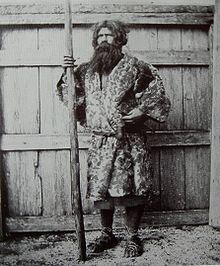In northern Japan, on the island of Hokkaido and a part of the Russian Sakhalin Island, lives a ethnic indigenous group, called Ainu. Ainu are shorter than the Japanese people, with lighter skin, robust body and short limbs. The Traditional Ainu culture is quite different compared to the Japanese culture. The Ainu people have wavy hair and the body hair is a lot. The Ainu men wear large beards and mustaches which a considered a sign of beauty. The woman even tattooed their lower facer to resemble a beard.
The ainu traditional cuisine consists of boiled or roasted meat such as bear, fox, wolf, ox and horse. They also consume fish, herbs and vegetables. They do not consume raw fish or flesh.
In Ainu, the people have a habit of capturing a bear cub where the woman is in charge of taking care of it like a child until its 2-3 years old, they will sacrifice the bear and the men will drinks its blood to get its power, as they are considered powerful spirits which can act on the benefit of the people.
Ainu lived in rectangular huts with walls and roof made of bundles of reed and rush without partitions and with a fireplace inside. There was no chimney, only a hole at the angle of the roof, one window and two doors. Without furniture, the family slept over platforms made of wood covered with rush mats, and as they did not have bed linen, they slept dressed.

Their traditional dress was a robe is made from the inner bark of the elm tree, called attusi. Most of the clothing consists of a simple short robe with straight sleeves, which was folded around the body, and tied with a band around the waist. Undergarments are worn by women.

The Ainu religion was animist where they believe that all the beings and many natural objects were endowed with a spirit. When a living being dies, the spirit is freed and this spirit can be good or evil. To avoid the evil spirits, the Ainu used to work on wood coarse representing the spirits, with a human form, called inaos. Today, inaos are simple sticks made by cuts of a knife. The inaos are thrusted into the grounds around and they are like prayers of the Ainu for protection.
The most important person in the Ainu village was the shaman, the person treating with the spirits. The shaman had other animal spirits which helped him in his spells to cure the diseases.
When an Ainu dies, his family ignite a large bonfire inside his hut and sends messengers for informing his friends and remote relatives. Sacrifices and libations are offered to the spirits, so that they will welcome the spirit of the dead, the family celebrate a banquet and the body buried the following day. The tomb is marked by a small mound and a wood and bamboo post crowned with a kind of an arrow, if the dead was a man, and with a rounded point.
Dancing and singing are very important to the Ainu. The rhythm is provided by singing and handclapping, and the women take the lead in dancing. One musical instrument attributed to the Ainu is the "mukkuri", which is made from a small, thin piece of bamboo. The instrument is held in front of the mouth and a sound is produced by pulling the strings.


No comments:
Post a Comment